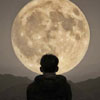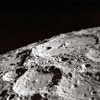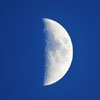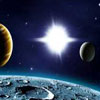There’s Intelligent Life On The Moon
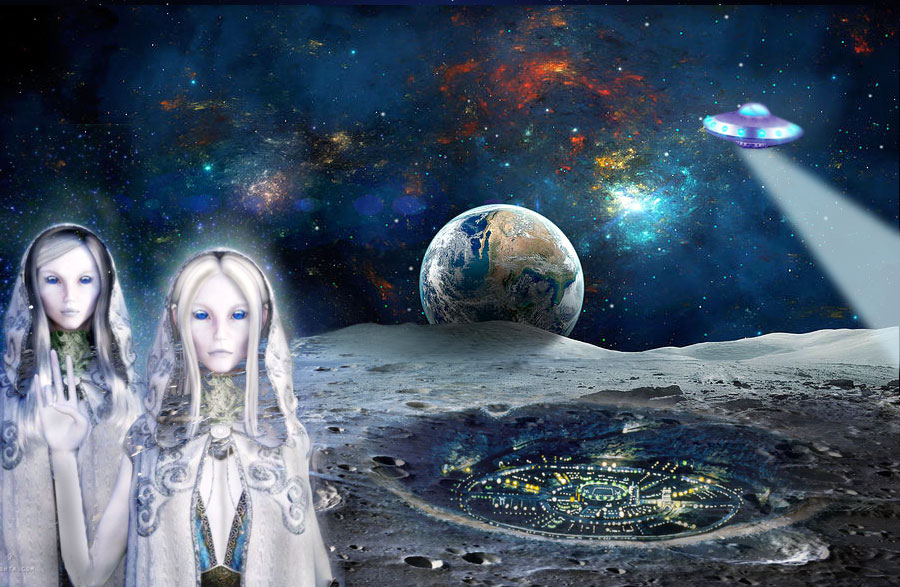 by Ray Palmer (May, 1959)
by Ray Palmer (May, 1959)
Even as this is being written, another American Moon Shot is scheduled. As you read this, it may have proven successful but what will be the information gleaned from it? Will you be told anything sensational about the Moon? Or will you be told the same nothing that has been released in the past ten years about the strange things astronomers have been seeing on our mysterious satellite? They won’t talk about it; perhaps because the subject has become painfully embarrassing. But the truth of the matter is that we’ve seen enough to make it imperative that we find out for sure! What is it the Russians learned on their close pass at the Moon that makes Kruschev offer the most fantastic proposal of all time- to quit rocket experiment FOREVER! Here, in this sensational article (all quite firmly documented) are facts that will stun you, as they have us. If you can’t stand to have your preconceived notions shattered, stop reading right now. If you read on, prepare to tear the chapter on The Moon out of your astronomy textbook.
What about the moon? Isn’t it a fact that it is a “dead” world; that it is completely airless; that it has no water, no vegetation, no life; that its face bears the scars of the impact of giant meteors which have left gaping craters; that its “days” are periods of intense heat, above the boiling point of water at Earth sea level; that its “nights” are periods of terrible cold almost at the point of absolute zero; that its plains are expanses of cosmic dust that no wind ever disturbs; that its “seas” are not seas at all, but arid plains or stretches of solidified lava from great prehistoric eruptions; that its volcanoes are long dead? If you took a course in astronomy in school, you know that these are facts that nobody questions; or if you read up on the subject in a manual of astronomy, you are familiar with their voice of authority on the subject. If you’ve ever looked through a moderately large telescope, you have seen for yourself the bleak expanse of a dead world.
Don’t fool yourself—not a word of it is true! Oh yes, the “craters” are there, and the immensely high mountains (much higher than mountains of Earth; considerably larger). And it is possible that the craters are the result of long-ago meteoric impacts; or of equally long ago meteoric impacts; or of equally long ago volcanic eruptions; or both. Actually, no one knows precisely how these strange markings came about. But beyond these salient features of the Moon, all the rest is sheer theory and mistaken observation and conclusion!
There are two ways we can observe the moon: We can look at it through a telescope, either visually or by photography. Usually we get best results from photographs; and also, eye-viewing is tiresome and a strain, so much so that sometimes the eyes play strange tricks (or so say the astronomers whose eyes have played strange tricks on them while viewing the moon). We can also “view” the moon by means of a varied assortment of gadgets, such as the spectroscope, which breaks down the moonlight and analyzes it to determine the elements present; or the infrared thermocouple, which measures temperature.
When the Big Eye, as the 200-inch telescope is called, was trained on the moon, great expectations were shattered. Actually, less was to be seen than with the smaller telescopes. The magnification was almost too great—because not only was the surface of the moon magnified, but the disturbances in Earth’s atmosphere also, which greatly hindered detailed examination. The best instrument for viewing the moon is a telescope in the 24” to 30” classification, such as the Schmidt.
Examining the moon with the spectroscope is singularly unproductive, and the results obtained are largely negative ones. For instance, examination for atmosphere shows 100% “lack” of everything, including oxygen. Without oxygen, of course, life is impossible. If there is an atmosphere, say astronomers, it is frozen solid at “night” and when melting in the “daytime” is almost impossible to detect, although some astronomers have reported a suspicion of an atmosphere detectable just after sunrise on the moon.
No air? Then what is it that causes meteors to become incandescent before they strike the surface? Oh yes, these plunging, flaming “shooting stars” have been observed repeatedly. They pass through something that provides sufficient friction to heat them to the point of giving off visible light. Not oxygen, perhaps, but some kind of gas.
No air? Then what are those “clouds” that are sometimes visible? And what strange medium is it that “refracts” light? If not air or water, then what?
But let’s not dally any longer—let’s get right down to cases and quotes. Let’s begin by taking up the subject of those meteors that are constantly plunking down on the unprotected moon surface. Here’s what astronomer Nininger had to say about them: Some 70,000 meteors per hour should fly at Luna. With no atmospheric blanket, they must smash into the surface at speeds of 40 to 70 miles per second. As a result, the surface of the moon should be blasted and churned and pulverized into a blanket of dust many feet deep. The U.S Army agreed with him. They said that even the tiniest solid object meeting another solid object at speeds much less than 40 miles per second (as little as one tenth that speed) would explode like a shell from a cannon. A meteorite weighing upwards of 10 pounds hitting the moon at 70 miles per second would stir up a ruckus as big as an atom bomb, and all the dust to go with it. Most astronomers went along with this view.
Astronomer Walter Haas, of Ohio State University estimated a 10 pound meteorite would make a big enough explosion to show in a telescope. In 1941 he organized a team of observers to watch for flashes due to meteorites hitting the moon, and on the night of July 10, 1941, Haas himself saw two flashes within the space of five minutes. Flashes, but no evidence of giant dust clouds. In a total observation time of 170 hours, his team of observers saw 12 fireballs flash across the dark disk of the moon. He attached no significance to this, or if he did, chose to ignore any implications except the desired one; that what was seen was the flash of impact.
In 1946, the U.S. Signal Corps, which had begun to be very interested in radar soundings of space, decided to turn their instrument on the moon. Peculiarly and coincidentally enough, astronomer Z. Bay of Hungary also began to take radar soundings of the moon. Try as they might, they could not find an area of the moon where the dust blanket was more than average of 1/25th of an inch!
This was something the astronomical experts couldn’t swallow, so they began a study of lunar dust by means of the new science of polarization. There was no doubt about it—volcanic dust strewed the moon. Elated at their victory, they went too far—they turned their attention to Mars, Venus and every other body they could reach—only to find out that the same volcanic dust strewed them all with equal impartiality. Mercury, Vesta, tiny asteroids incapable of having volcanoes, all showed volcanic dust. Back to the moon, and more detailed study—this time of the sheer walls of crater cliffs, the same amazing layer of volcanic dust, defying gravity, hanging to perpendicular walls as if glued there.
Both the volcanic theory and the meteor theory were blasted into fictional category. But unfortunately the books had already been printed, so there the two theories remain, buried in non-existant dust. Both you and the books will become dust one day, but it won’t be moon dust!
The next “fact” to face attack was the moon’s lack of atmosphere. Mathematically, it is easy to prove that it is scientifically impossible for the moon to have an atmosphere because lunar gravity, one-sixth that of Earth, is too weak to hold the fast moving molecules of atmospheric gases, even at ordinary temperatures. But under the impetus of “daytime” 212 degrees (Fahrenheit) readings, it is wholly apparent that all the molecules have escaped into space. Proof of this was easy to obtain. Atmosphere produces clouds- no clouds had ever been seen on the moon. Atmosphere refracts (bends) light, and when the moon passed in front of a star, its light was not bent so that it “jumped” out of place at the last moment. But some persistent observers kept watching, and before long, reports of refraction began to come in. Came also reports of clouds: red, gray, white—some so dense they cast shadows. On some occasions, the crater Plato, which is 3,000 square miles in area, is seen to cloud over almost entirely. Some of the craters near the poles are observed to whiten at the rims as though frost or snow has been deposited on them. The fireballs seen by Haas and his crew, leaving long fiery trails behind them as they crossed the dark area of the moon transversely, could only have been ignited to incandescence by friction with some sort of atmosphere.
But how could the spectroscope, for instance, be so wrong? Recently this worried the Russians, and they put one in a Sputnik. In a spasm of ill-mannered humor, they directed the spectroscope back toward the Earth, and thereby gained the bitter hatred of many astronomer authors of books on interplanetary spectroscopy—because the faithful instrument reported blithely the Earth’s atmosphere showed a complete lack of oxygen, thereby making it incapable of supporting human life. You and I (and the astronomers) were spectroscoped right out of existence. If the Martians look at us through their spectroscopes, they are complacently aware that we do not exist. Those few lichens that cling to our bleak surface can never pose a threat to their existence.
Some inquiring persons, thus finding questionable features in spectroscopy, began also to question polarization. Could it be that the studies showed universal volcanic dust on all interplanetary bodies because what was being studied was merely volcanic dust in Earth’s own atmosphere, which intervened, and which is always present to a greater or lesser degree? It could be, and it was! None of the polarizers could prove otherwise.
Back to their telescopes went the observers, and back came the eye strain. Once more things began to be seen that were not explainable except as eye strain. To go back and list some of the older cases of eye strain, let’s begin with Gruitheisen, 130 years ago he noted some weird markings just north of crater Schroeter. They were curious formations of crisscross lines and squares that bore a startling resemblance of today’s long range aerial photos of city blocks and streets. Gruitheisen was branded a crackpot for calling his discovery a city, but the non-crackpots could not offer a better explanation, although when they looked where he pointed, they saw the markings precisely as he had.
This wasn’t the first “city” to be discovered. There are large ones in the craters named Plato and Gassendi. Later Gruitheisen’s “city” seemed to be growing. Several new “blocks” and “streets” lengthened. If this was a city, there was new construction going on. Nininger found what appeared to be a glassed-lined tunnel 20 miles long connecting craters Pickering and Messier. He theorized this was caused by a glancing meteorite, although the debris that should be scattered about is not observable. As we have previously seen, even if the debris was pulverized into dust, it still is not there.
In December, 1915, crater Aristarchus suddenly developed a long black wall that ran from its center to one rim. In 1922 three long “mounds” showed up on the floor of crater Archimedes. Three more, arranged in the form of a triangle, appeared shortly after, and were seen to be connected by low walls. The French reported a long curving wall, and another with arches that resembled those of a viaduct.
Near crater Birt is a queer upthrust formation that looks like a sword—or the spire of a cathedral. But the oddest of all formations, a crater named Linne, got its reputation for oddity about 80 years ago. Up to then, it had been a small black crater on the vast expanse of Mare Serenitatis. But one night, astronomer Schmidt, in Athens, happened to be looking at it when it changed from a black cone to a white pyramid edged with black. Then it disappeared completely. A few nights later that area was as empty of a crater cone as if it had never existed. Astronomers the world over were amazed. They were even more amazed when Linne suddenly reappeared. Finally it disappeared, and remained away so long that lunar maps were changed, leaving it off. To drive the map makers crazy, it reappeared after the maps were printed. Then, during an eclipse, it blazed out like a lighthouse. Another time, when its area was in the dark portion of the moon, a white spot was seen slowly climbing up its slope. The last antic of Linne has been to turn into a large gray spot that changes shape and size. What it will be when you read this is anybody’s guess.
But Linne wasn’t the only disappearing crater. Early in the nineteenth century, Schroeter was studying the moon’s wobble by the advance and retreat of the sunlit rim. For a reference point from which to measure, he used the 23 mile crater Alhazen in Mare Crisium because it was near the northeast rim and stood out prominently.
About six years ago British astronomer H. P. Wilkins was hard at work on his magnificent eight-foot map of the lunar surface. Checking on Alhazen, he discovered to his amazement that it wasn’t there any more. Where it had been was just vacant space. Wilkins, decided that Alhazen had followed the example of Linne and changed its color, but this time a color that merged exactly with its surroundings. It was still there, reasoned Wilkins, just not visible. But search as he might, he could not find any evidence of its shadow, which could not have changed its color.
In May, 1877, Klein saw a large and conspicuous object in the crater Hyginus. It hadn’t been seen by anybody before, but it could not be missed now. It was named Hyginus N, and shortly thereafter it disappeared as though it had never been. A year later it popped up again. It vanished, came back again, vanished a final time. In its place is a big black gash.
Procius changes from dusky gray to pure white with brilliant streaks. In Eratosthenes, large spots change size and shape from one night to the next. Other spots appear near the center of Ptolemy. Spots in Plato, Aristrachus, Schickard, Hyginus and others go through a regular schedule of changes. A large dark patch east of Aristarchus can be seen with the naked eye. Photographed in blue, infrared, or ultraviolet light it becomes coal black. Photographed by yellow light it disappears completely.
Astronomer Walter Haas thinks the patches are radioactivity areas. To prove his point, he set another team of observers to work during the eclipse of August 26, 1942. During the eclipse, two dark patches popped up in Atlas and remained for four hours after the eclipse. A cloud on Conon got smaller; and not to be outdone, Linne shrank in size while brightening considerably. Firmicus and Webb darkened, but spots in Grimaldi got into the act by one of them darkening while the other brightened. Pico and Ricciolo sported their own parade of changing features. During the eclipse of 1949, Aristarchus went crazy with moving spots, glowing lights, and assorted antics. Haas turned a thermocouple on craters Grimaldi and Eratosthenes during the 1949 eclipse and found that whereas the darkness temperature has been measured at 250 degrees below zero, the patches in these two craters were very much warmer. Radioactivity, said he. Volcanoes said others. But when Dicke and Beringer took lunar temperatures with a radio device, they didn’t agree with thermocouple readings at all. Now nobody knows what is hotter or colder or why. The argument seems destined to go on until one of our rockets reaches the moon to take on-the-spot readings.
Black blotches on the moon seem to flit about with no rhyme or reason. Shadows are supposed to be cast by objects, yet in Plinius and Copernicus (on the same night) a whole group of black blotches appeared. A few weeks later a huge blot perched atop the rampart of Gassendi, above one of the “city” formations, stayed for a few nights, then went away. A similar black blot, but this one surrounded with a halo of brilliant white, appeared in Plinius. In October, 1916, a red-tinted shadow swept across Plato. Similar red shadows hovered over Hercules and Gassendi on different occasions. Two British astronomers on an expedition in New Zealand saw “a large part of the moon covered with a dark shadow equalling the shadow of the Earth during an eclipse,” but there was no eclipse. Something huge had to cast that shadow, but what could it have been? Certainly not that of any known body. Dr. F. B. Harris, on January 27, 1912, saw “an intensely black object about 50 miles by 250 miles in size, which resembled a crow poised, as near as anything”.
Lights keep winking at us from the moon. Such as the extremely bright triangles that appeared on the moon’s lower limb, then vanished, only to be replaced three minutes later by two vast black triangles obscuring almost a fourth of the lunar surface. They looked like slices of pie notched out of the edge of Mother’s Best by impatient little boys. The triangles crept toward each other, and finally merged. Then they vanished. Professor John Haywood has seen the whole dark disk of the moon glowing with a weird misty light. Reverend Rankin and Professor Chevalier saw a dizzy kaleidoscope of lights swirling amid the shadows.
Almost 200 years ago Sir John Herschel reported a dozen or so very bright lights on the moon during eclipses. He was puzzled, however, because some of them were above the surface. For more than 100 years a bright light has been seen in Aristarchus and at the eastern base of the lunar Alps. One 4th of July the whole plain of Mare Crisium celebrated with a spectacle of dots and streaks of light. Messier sports two bright lines separated by a very dark band dotted with luminous points. Long lines of light like fuminous cable is seen in Eudoxus and Aristarchus, together with moving lights.
Plato is a great show-off with strings of moving lights, occasionally varied with a triangle of light. In 1869 thirty bright lights broke out on its floor all at once and went into a routine. They sorted themselves into groups. One group would blaze up brightly, while another darkened. It was as if someone were operating a signal keyboard of some kind. The Royal Society observed the phenomenon until April, 1871, and recorded 1,600 observations and drew 37 graphs of the light fluctuations in the hope of establishing some sort of pattern. They talked of “intelligent attempts to signal Earth”.
During eclipses shafts and horns of light are seen shining out from the moon. Squadrons of light and dark bodies seem to maneuver in the lunar sky. On November 16, 1910, during an eclipse, a bright light shone on the moon, and two widely separated observatories saw a ball of light shoot out from the moon.
C. Stanley Ogilvy of Trinity College admits these lights exist, but attributes them to tiny uncharted asteroids passing in front of the moon. Astronomer Walter Haas has stated that noted astronomers have seen things on the moon which they refuse to report, or even discuss. More lately, Mount Piton, in northern Mare Imbrium, has begun to light up, and even send up beacon-like beams.
March 19, 1848, was to have been a night for a lunar eclipse. It never came off. Instead, the moon turned blood red, then it got three times as bright as normal. Astronomer Walkey didn’t know what to make of it. He offered no apology, however. Not to be outdone, Scott’s Antarctic Expedition kept a scientific rendezvous with a lunar eclipse in 1903. Nothing whatever happened. On April 28, 1930, the moon was due to eclipse the sun. The astronomers had predicted a band of shadow one-half mile wide. Instead, it was five miles wide. Dr. Jeffers of Lick Observatory, betraying a note of hysteria, issued a public statement that this did not necessarily mean the moon was closer to Earth than it was supposed to be.
In the line of intelligent communications, about ten years ago a group of white spots appeared on the floor of crater Littrow in the form of the Greek letter Gamma. Eratosthenes followed this up with a gigantic structure in the shape of an X. Not to be outdone, Plinius evolved a completely baffling figure not remotely related to any letter or script. As if to rebuff these crude literary attempts, the Royal Astronomical Society failed even to list the Moon in its index of subjects in its Monthly Notices. Most of the other long-hair magazines have ignored the Moon in much the same manner in recent years.
Just a few years ago, a giant bridge in Mare Crisium was reported. It looked “artificial”; but whether it was or not, it hadn’t been there previously. Major Keyhoe used it in his broadcast over the Armstrong Circle Theatre, where he was victimized by an army-rigged attempt to discredit flying saucers. One of the Army stooges, Donald Menzel, who professes to be be an astronomer, flatly stated the bridge report was a falsehood, and produced pictures of Mare Crisium to prove it. But Dr. Percy H. Wilkins, one of Britain’s top astronomers, has this to say: “The bridge is there, and it appears almost like an engineering job.” Dr. James C. Bartlett, American astronomer, and Patrick Moore have also seen it and so stated.
While speaking of this bridge, Dr. Wilkins revealed that there is a new phenomenon on the moon which is popularly termed “the bowler hat”. No such objects were visible on the Moon 200 years ago, while a dozen or so were observed between 1860 and 1879. Now, however, there are more than two hundred. Wilkins is supported in this by Tulane University. These domes, most of them, are older than the bridge which appeared in 1953.
Peculiarly enough, lunar-probing scientists today are planning plastic “shelters” to erect when they finally reach the moon, and although they exist only on paper as yet, if one were to be erected on the moon, and some astronomer had his telescope trained upon that area, he might add another “bowler hat” to the number already reported.
Back in 1946 or thereabouts, the Army made a frightful mistake in issuing a graph of a radar signal bounced off the Moon which showed the moon to be only 120,000 miles away. It was retracted and replaced by a corrected graph in the afternoon papers, but one cannot help wondering how such an erroneous graph came to be drawn up in the first place. The whole radar “bounce off the Moon” had been so meticulously carried out, as is the Army’s wont. But back in the last century, there were astronomers who calculated that the Moon might not be where we think it is at all. Some even said 70,000 miles away.
The whole question of the distance of the Moon is another of those instrumental calculations, those mathematical geometrical estimations which give us the value of “x”. Geometrically speaking, if we know two angles of a triangle and one side, we can calculate the other two sides. So, measuring a distance on the Earth, sighting at the Moon from a point on each end of this distance, two known angles are determined. Presto, you have the distance to the moon, as represented by the two unmeasured sides, which can now be calculated by any high school student. It comes out approximately 240,000 miles away. The ancient Greeks figured it as 235,000 miles away, using the same system, so it hasn’t changed in 4,000 years. But those astronomers who so avidly seized upon refraction to prove the absence of atmosphere on the Moon, refused to take it into consideration when measuring the Moon’s distance from Earth. They chose to ignore the very significant refraction index of the Earth’s atmosphere, and blithely assumed that the light rays coming from the Moon traveled in a perfectly straight line all the way from Moon to Earth. Actually they must be bent severely upon striking the atmosphere and swerve sharply inward, thus giving very incorrect values for the angles we use in finding our “x” distances. Either atmosphere does not refract light (and astronomers insist it does) or the Moon is nowhere near as far away as they have calculated it to be.
The world today is agog over the tremendous achievement in rocket power the Russians have developed. In order to shoot an entire rocket past the moon and into orbit around the sun, they must have motors of tremendous power, in the million pound thrust range. That is, if the Moon actually is 240,000 miles away. But if it’s only 120,000, then their rockets are the same as ours. And if the Russians know that they are the same as ours, then the Russians must also know, perforce, that the Moon is nearer than Americans think. Knowing would make hitting the target as closely as they have possible. Not knowing it would make our rockets miss as far as they have.
On November 12, 1958, Russian astronomer Nikolai Kozyrev announced that he had seen a volcanic eruption on the Moon on November 3. He made his observation from the Crimea with a 50” telescope (mirror). He noted a reddish outline around the Alfons crater, and obtained an unusual photograph of the center peak of this crater. The process started with ejection of volcanic ash, causing a reddish outline around the volcano, followed by the normal eruption of gases. About 20 pictures were taken over a three week period.
On November 19, British astronomer Wilkins got a look at the eruption through a 15 1/4” telescope and confirmed the existence of the reddish patch, which he said was about 1 ½ miles across, slightly south of the central peak of Alphonsus crater. “It’s revolutionary,” said Wilkins.
And there you have it. The Moon is not the dead world we’ve been taught to believe it is. It’s very much alive, and if we can believe our eyes, it is inhabited. The very next Moon rocket may confirm what many astronomers already privately believe. If you are lucky enough to have a moderate sized telescope available, you can become convinced yourself after a period of concentrated observation.
There’s SOMEBODY on the Moon!
Excerpt from Flying Saucers Magazine
See Part I here.
Posted in Life On Other Worlds, Other Topics, The Moonwith comments disabled.


